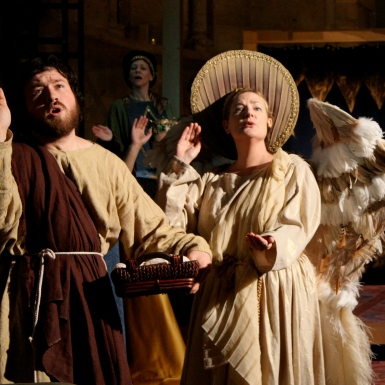“Book of Daniel” receives vibrant, imaginative staging at Rockport

“The Book of Daniel” was performed by Gotham Early Music Scene Friday night at the Rockport Chamber Music Festival.
Half a century ago, The Play of Daniel was one of the works that sparked greater awareness of early music. The thirteenth-century liturgical drama is now one of the cornerstone masterworks in a wide-ranging field that is especially robust in the Boston area.
Friday night, New York’s Gotham Early Music Scene brought the ancient drama to the stage of the Shalin Liu Performance Center as part of the Rockport Chamber Music Festival.
Dating from about 1200, The Play of Daniel was composed in the northern France town of Beauvais, probably by a redactor and his students, for Feast of Fools performances at the local cathedral. Its tightly-wound story tells of the Old Testament prophet Daniel, whose visions topple a Babylonian king and whose faith spares him from death in the lion’s den. Manuscript sources for Daniel leave much room for guesswork. Stage directions are scant, and the score comprises only melodic pitches and text.
GEMS directors Drew Minter, Jeffrey Johnson, and Mary Anne Ballard reconstructed Daniel for a 2008 performance to celebrate the fiftieth anniversary of Noah Greenberg’s ground-breaking New York Pro Musica production.
As evidenced in this performance, theirs is a freshly realized and theatrically colorful interpretation, incorporating hand gestures and choreography—rhythmic clapping and round dances—drawn from medieval iconography and ancient liturgical practices. The performers made use of the entire hall for a stage with musicians and singers wandering and marching up and down the aisles. Decorative medieval-style costumes and warm lighting created an atmosphere suited to the melodious and ear-catching music.
Listeners familiar with Greenberg’s version will recognize a few musical similarities here, especially the use of sprightly instrumental music and gently swinging rhythmic treatment of the vocal lines, as in the early chorus “Astra tenenti.”
But likenesses stop there. GEMS’ production contains original music cast in the austere open intervals of medieval polyphony. In addition, the score isn’t restricted to notions of historical authenticity, and clever use of more modern sonorities helps tell the story.
Belshazzar, son of Babylonian king Nebuchadnezzar, is enjoying a courtly feast when mysterious writing appears on the wall. Scratching glissandi in the rebec (a medieval fiddle) and a squawking shawm (double-reed predecessor to the oboe) underscores the king’s astrologers in their blundering attempts to decipher the message. When Daniel is summoned to explain the writing, shimmering harmonics played by recorders, strings, and percussion—this includes a waterphone (a bowed instrument made from wires and water-filled stainless-steel bowl)—added an eerie and other-worldly effect.
Much of the vocal writing remains true to the original source, and the singers rendered the unison choruses with soft and sensitive tone. Standouts in the cast included tenor James Ruff who sang purely and expressively as Daniel. Bass-baritone Peter Walker was a solemn Belshazzar. His lush singing was also well-suited in the role of Habakkuk, the prophet ordered by an Angel to bring Daniel food in the lion’s den.
Soprano Sarah Pillow delivered the role of the Babylonian Queen with a smooth, silky voice. José Lemos’s countertenor shined as the Persian king Darius, who conquers Belshazzar’s kingdom just as the writing on the wall foretold.
Posted in Performances



